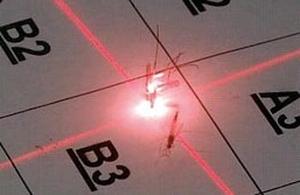Killing malaria bugs dead with laser
Mosquito-killing laser demonstrated; if bed nets are the low-tech solution to combat the deadly malaria — caused by a parasite transmitted when certain mosquitoes bite people — the laser is a high-tech one; the laser detection is so precise, it can specify the species, and even the gender, of the mosquito being targeted

Mosquitoes killed by laser // Source: dvice.com
In a video on the IntellectualVenturesLab’s Web site, you may watch what happens to a mosquito at the instant it is zapped by a laser, all in slow-motion. The device is the brain-child of Nathan Myhrvold, Microsoft’s former chief technology officer. His company, Intellectual Ventures, has been developing the mosquito laser since 2008 as part of an effort to eradicate malaria (one of the team’s inventors, astrophysicist Lowell Wood, had helped design the cold war-era Star Wars laser shields in the 1980s). The company has assembled commonly available technology — parts used in printers, digital cameras, and projectors — to make rapid lasers to shoot down mosquitoes in mid-flight. The New York Times’s Jennifer Lee writes that if bed nets are the low-tech solution to combat the deadly disease — caused by a parasite transmitted when certain mosquitoes bite people — the laser is a high-tech one.
Nyhrvold gave the first public demonstration of the laser, which was cobbled together from parts found on eBay, at the annual TED conference in Long Beach, California, which features lectures and demonstrations by experts in a wide range of fields, including technology, politics, and entertainment.
After hundreds of mosquitoes (which were kept in the hotel bathroom until showtime) were released into a glass tank, a laser tracked their movements and slowly shot them down, leaving their carcasses scattered on the bottom of the tank. The demonstration was slowed down for public viewing, but Myhrvold said that normally the lasers could shoot down anywhere between 50 to 100 mosquitoes per second.
Myhrvold played a slow-motion recorded video that showed what happened to a representative mosquito. As the insect flew, a sudden light beam struck it, disintegrating parts of its body into a plume of smoke. It fell, even as its wings continued to beat.
Myhrvold said the software detects the speed and size of the image before deciding whether to shoot. It would reject a butterfly or a human, for example, and more powerful laser blasts could be used for locusts. In regions afflicted by malaria, the lasers could be used to create protective fences around clinics, homes, or even agricultural fields as a substitute for pesticides.
Lee writes that the idea was born from a 2008 brainstorming session held on strategies for killing malaria-bearing mosquitoes, a particular interest of Myhrvold’s friend and former boss, Bill Gates, who has made the illness one of priorities of the Bill and Melinda Gates Foundation (to the point that Mr. Gates released mosquitoes into the audience at last year’s conference).
The idea of lasers was thrown into the mix. “Everyone was like, ‘C’mon, be serious,’” Myhrvold said in an interview with Lee after the demonstration. After doing a little bit of research, he said, his team concluded that “this is feasible. We can actually do it. So we did.”
The breakthrough relied on understanding how the technology that guides the precision of laser printing could be combined with the image-detecting charge-coupled devices, or C.C.D.’s, used in digital cameras and powerful image processing software. Myhrvold said he thinks there is particular potential in the Blu-ray laser technology, because blue lasers are more powerful than red ones and there are a lot of them being made cheaply now.
He estimates that the devices could potentially cost as little $50, depending on the volume of demand. His company, however, would not manufacture them. Rather, it built the technology mostly as a proof of concept. Other companies would have to take the laser technologies to market, so the timeline for seeing the lasers in common use is uncertain.
Lee notes that the laser detection is so precise that it can specify the species, and even the gender, of the mosquito being targeted. “The women are bigger. They beat at a lower frequencies,” Myhrvold said. Since it is only the female mosquitoes who bite humans, for the sake of efficiency, his system would leave the males alone.
